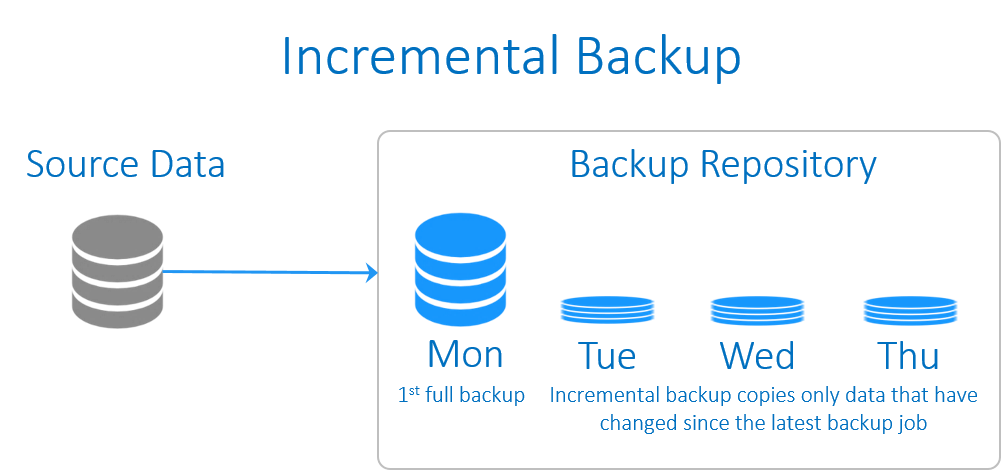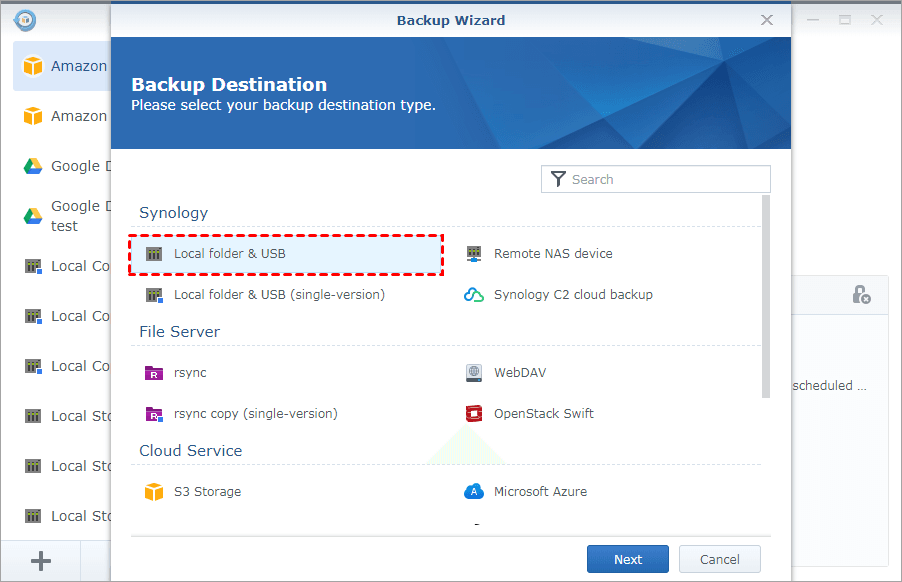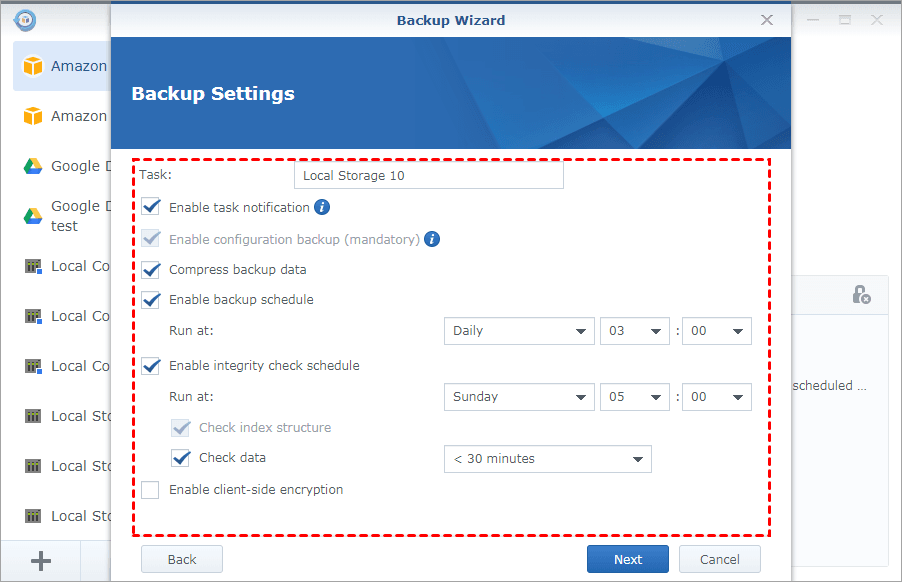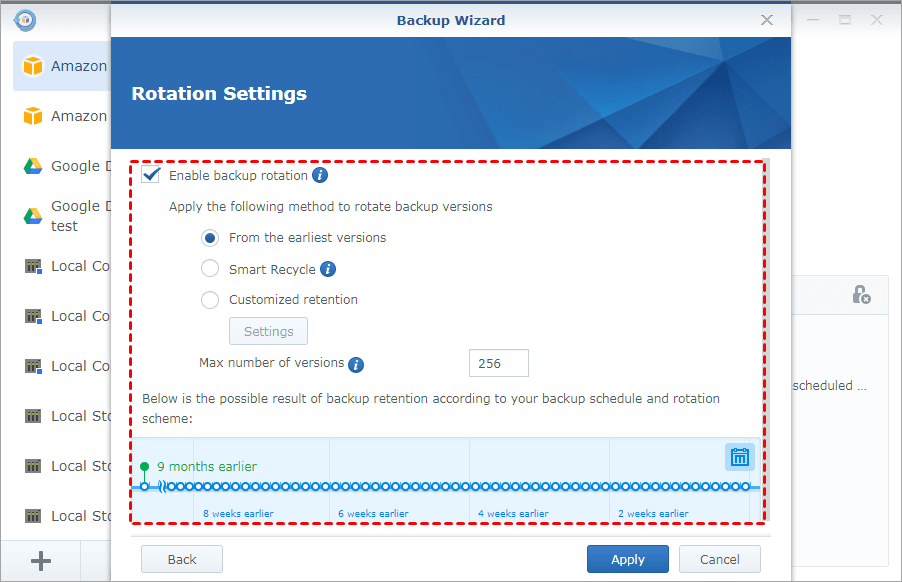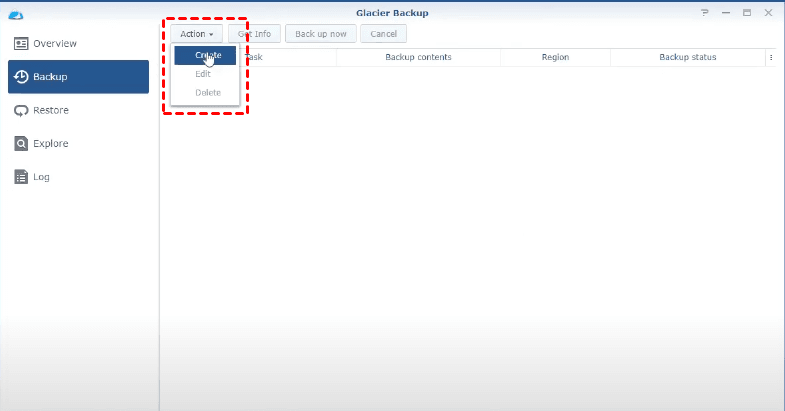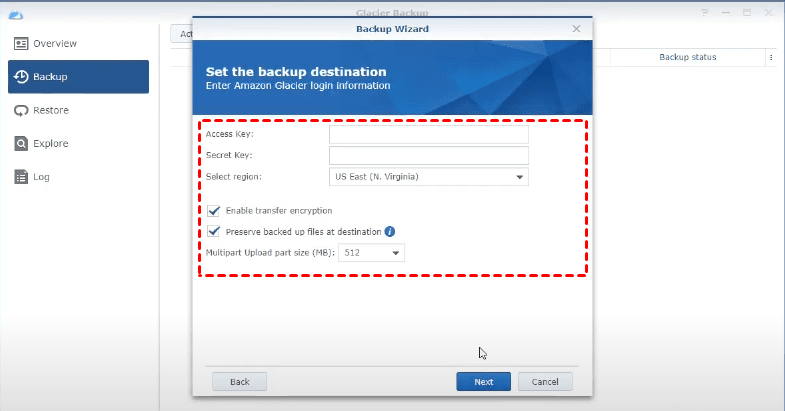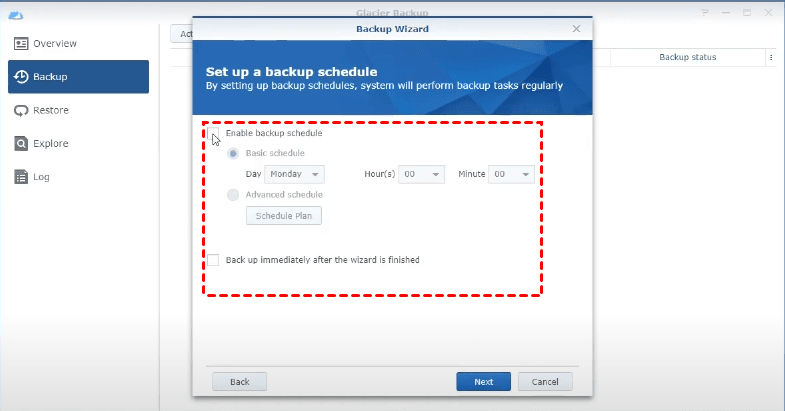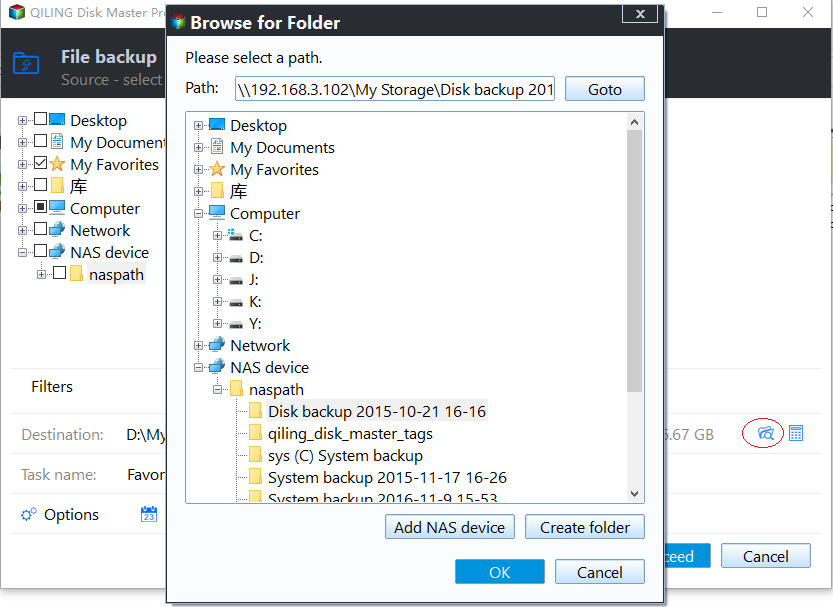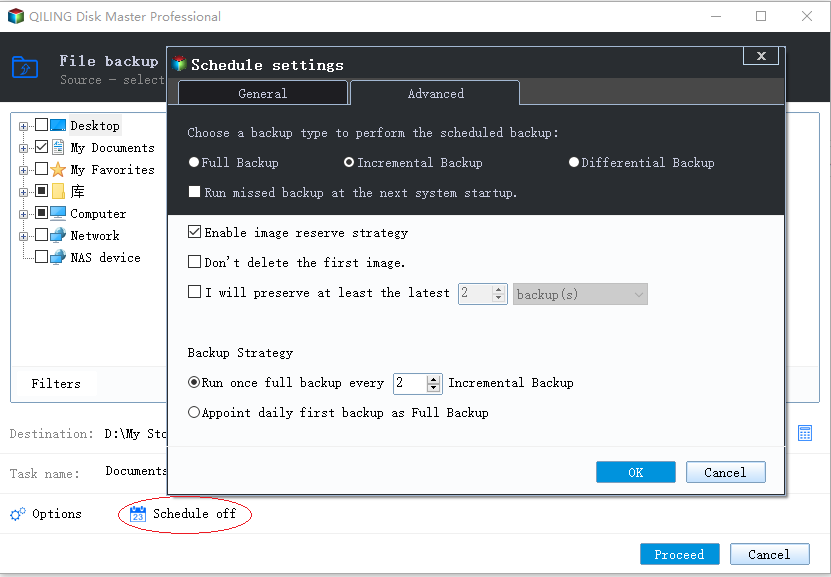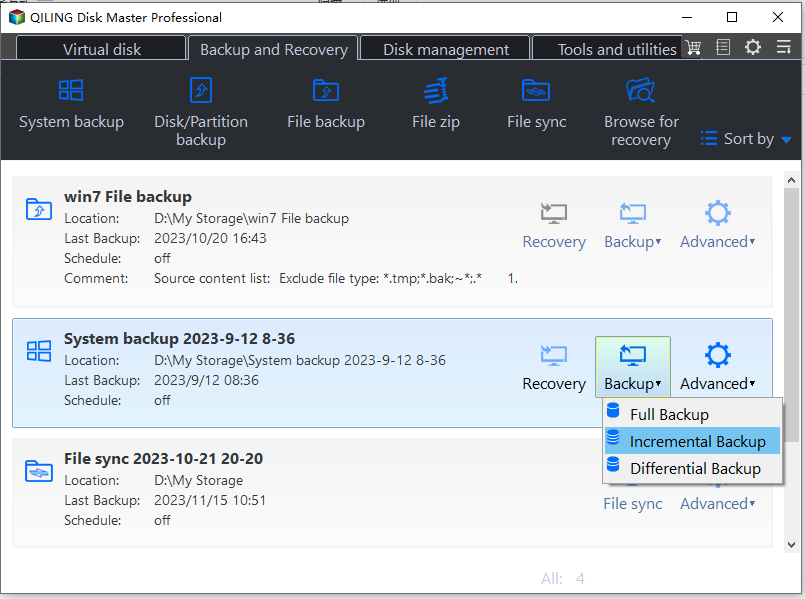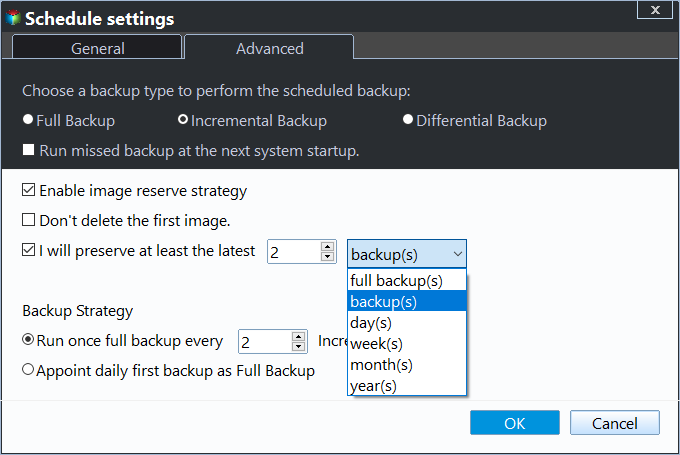Top 3 Methods for Synology NAS Incremental Backup
What is Synology Incremental Backup
Synology incremental backup Incremental backup refers to backing up only the files that have changed or were newly added since the last full or incremental backup, to or from a Synology NAS. To restore data, the last full backup plus all incremental backups up to the desired restoration point are required.
The pros and cons of Synology incremental backup
| Pros | Incremental backup takes up minimum space and time in backup compared to other modes. It saves your resources when you back up data to Synology NAS, or from Synology NAS to other locations. |
| Cons | The restoration of incremental backup needs both the last full backup and all the subsequent backups in order, which increases the recovery time. And if you lost any of them, the recovery will not succeed. |
Synology incremental backup vs. differential backup
Incremental backup and differential backup are two commonly used backup modes that only back up changed files. However, the key difference between them is that a differential backup captures the changes in data since the last full backup, whereas an incremental backup captures the changes since the last full or incremental backup.
In addition, a full recovery of a differential backup requires the last full backup plus the latest differential backup, making it faster to restore than an incremental backup. However, this approach also consumes more storage space and takes longer to back up. Consequently, when it comes to Synology NAS backup, incremental backup remains the more popular choice.
🔰One tool for either incremental or differential
Perform incremental/differential/full backup with Synology NAS, or other network locations, local folders, external drives, cloud services, etc. More »
How to Perform Incremental Backup for Synology or Other NAS
Synology NAS offers a range of add-on packages that can enhance its functionality. For instance, packages like Hyper Backup and Glacier Backup, which can be easily installed from the Package Center, enable incremental backup capabilities.
While the built-in backup tools on Synology NAS, such as Hyper Backup and Glacier Backup, are convenient, they are limited to Synology NAS and have some restrictions on features and supported storage devices. In this case, users may want to consider using an alternative program to achieve a more robust incremental backup solution that can be applied to a wider range of NAS devices and other storage systems.
- Method 1. Use Synology Hyper Backup to do incremental backup
- Method 2. Use Synology Glacier Backup to do incremental backup
- Method 3. Best Software to schedule incremental backup for all NAS
Method 1. Use Synology Hyper Backup to do incremental backup
Hyper Backup is a data backup utility specially developed for Synology NAS. It supports backing up data to local shared folders, external storage devices attached to your Synology NAS, remote Synology NAS, file servers, and cloud services.
Synology Hyper Backup employs a space-efficient incremental backup approach, which minimizes storage space usage. After an initial full backup, only new or modified data is backed up, ensuring that subsequent backups are smaller in size and consume less storage space. This incremental backup method saves storage space and streamlines the backup process, making it ideal for users who need to manage their data storage efficiently.
To access Synology Hyper Backup, please log in to your DSM (DiskStation Manager) and navigate to the Package Center. From there, search for Hyper Backup and download it to get started with your backups. This straightforward process ensures that you can easily install and utilize the Hyper Backup feature on your Synology device.
Please note that Synology Hyper Backup is compatible with DSM 6.0 or later versions. If your Synology NAS is running an older version, you will not be able to install and use Hyper Backup, as it is not supported on those versions.
After downloading and installing Synology Hyper Backup, follow these steps to create an incremental backup on your Synology NAS:
1. To create a backup task, launch Synology Hyper Backup and click the "+" button. From the menu, select "Data backup task".
2. Next, select a backup destination. If you want to perform a Synology incremental backup to a USB drive, attach it to the NAS and choose "Local folder & USB" from the menu. Click "Next" to proceed.
3. Choose "Create backup task" and select a local shared folder or an external storage device connected to your Synology NAS, such as a USB drive. You can also rename the "Directory" as desired. Click "Next" to continue.
4. Select the source data you want to backup and click "Next". If you're backing up an encrypted shared folder, make sure it's been mounted during the process, as it won't be visible in the list otherwise. Then, click "Next" to proceed.
5. Configure your backup settings, including compression, scheduling, encryption, and more, to tailor the backup process to your specific needs.
Enable backup rotation Set the maximum number of incremental backup versions to store, then click Apply to save the changes.
6. Execute the backup task immediately.
For the initial backup, a full copy of the source data will be created. Subsequent backups will only store the changes made since the last backup.
Click here to find out more about setting up Synology incremental backups to USB or local shared folders.
Method 2. Use Synology Glacier Backup to do incremental backup
As a Synology NAS add-on package, Amazon Glacier Backup offers secure and durable data storage at affordable costs. It allows you to back up files to your Amazon Glacier account, freeing up space on your Synology NAS and providing a safeguard against data loss in case of an emergency.
Before utilizing Synology Glacier Backup, you'll need to register and set up an Amazon Glacier account through AWS. Once this is done, you can download the Glacier Backup package from the Package Center of your DSM.
1. Launch Glacier Backup, click Backup > Action > Create.
2. Name the task, agree to the conditions, and then click the "Next" button to proceed further.
3. Enter your Amazon Glacier account's Access Key and Secret Key. You can also optionally enable transfer encryption or configure the multiple upload part size.
4. Specify the data you want to backup and click Next.
5. Next, set up a schedule for your backup. This will create a full backup at the first run, and then store only changed files, allowing you to achieve incremental backup functionality for your Synology NAS.
Method 3. Best Software to schedule incremental backup for all NAS
While the previous methods are suitable for Synology NAS with basic features, if you have more complex backup needs, such as backing up data from various devices, like QNAP NAS or scheduling NAS backups, this alternative approach may be more suitable for you.
◆ Qiling Disk Master Standard, a comprehensive backup and restore program, offers the flexibility to select various sources and destinations, including internal/external hard drives, USB drives, cloud drives, NAS, and more. It allows you to choose from these options as the source or destination for your backup and restore operations.
◆ It supports full/incremental backup, with or without schedule. And you can choose intelligent or sector-by-sector backup, compress or splitting image as well.
◆ You can enjoy advanced features in rofessional edition, such as backup filter, backup encryption, schedule backup triggered by events or USB drive, differential backup, ackup scheme to auto delete old backups, etc.Professional edition, such as backup filter, backup encryption, schedule backup triggered by events or USB drive, differential backup, ackup scheme to auto delete old backups, etc.backup scheme to auto delete old backups, etc.
Now, I'll guide you through the process of performing a Synology NAS incremental backup using the completely free Standard version of Qiling Disk Master. You can also follow this process to backup other NAS or devices.
(PS: Note that the free version of Qiling Disk Master is only compatible with Windows 11/10/8/7/XP/Vista. If you're a server user, you may want to try Qiling Disk Master Server, which offers a discounted rate of 70% off for a single server computer.)
1. To begin, install and launch the software. Then, navigate to the left pane and click on Backup.
If you wish to back up local partitions, the system, or the entire hard drive to a NAS or other locations, you can make your selection accordingly.
2. Click on Folder or Files to specify the source data. To back up data on a Synology NAS, please select Share/NAS in the pop-up window.
Click on Add Network Location to enter the path to your NAS. Hit OK. Then, select the folders or files in the NAS, and click OK to proceed.
3. Specify a target directory. For removable devices like USB or external hard drives, connect them to your computer first. If you want to back up your NAS to another network location, repeat the process described in the previous step.
4. Before Proceed, you can manage backup settings as you like:
To set up automatic incremental backups for your Synology NAS, click on the Schedule Backup option at the bottom and configure the frequency of the backups.
By default, a scheduled backup runs in incremental mode, except for the first full backup. Subsequent automatic backups will only back up changed data to the NAS. In the Backup Scheme tab, you can also choose the scheduled backup mode.
Note the differential backup is available in Professional edition.
In addition to scheduled backups, you can also run incremental or differential backups manually. To do this, complete a full backup without scheduling it first, then go to the Home tab, select the task, and choose Backup > Incremental Backup or Differential Backup.
While incremental backup requires the least storage space among the three backup modes, it's worth noting that if you run a scheduled task over a long period, the accumulated image files can eventually fill your NAS or other devices, making it difficult to restore a specific version.
In this scenario, you may want to consider upgrading to a more advanced edition, such as Professional, which offers the automatic backup cleanup feature in the Backup Scheme. By setting up a backup scheme, you can intelligently delete old backups, thereby freeing up storage space.
✍Tips:
- Increasing the compression level in Options can result in a smaller image, but it may also lead to a longer backup time.
- To create incremental backups to a Synology NAS, select the source and target paths accordingly.
- From version 6.1 onwards, you can also add or manage NAS devices in **Tools** > **Share/NAS Management**.
Conclusion
Synology's incremental backup feature can greatly save time and storage space, and there are add-on packages available to support this. However, if you want to apply this to other NAS or devices, a third-party program like Qiling Disk Master may be more effective.
In addition to incremental and differential backups, File Sync also allows for complete NAS mirror backups. If you need to backup multiple PCs or servers to a NAS, there are also Technician and TechPlus editions available, which can be compared on the dition comparison page.edition comparison page.
Related Articles
- How to Free Backup Windows 7/8/10 Data to Synology NAS
Synology Data Replicator has reached the end of its lifespan. What if you want to backup data on Windows 7/8/10/11 to Synology NAS? See this article and find your alternative way. - Synology NAS Backup to External Hard Drive [2 Free Ways]
It is necessary to backup Synology NAS to external hard drive for data security and this article provides you with 2 safe and free ways. - How to Do Incremental and Differential Backup in Windows 10
If you have backed up for your important data, but there is some changed or added files, how to do? Doing incremental and differential backup in Windows 10 may be a wise choice. - Windows Server Backup: Differential & Incremental Backup
Understand how Windows Server Backup differential backup works (although Microsoft calls it incremental backup) and get the methods to take differential or incremental backup in Server 2008, 2012, 2016, etc.
